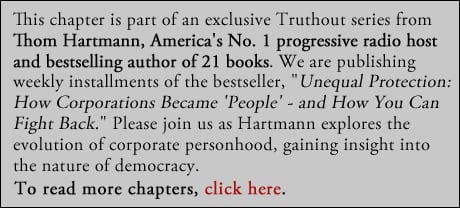Part of the Series
Thom Hartmann | Unequal Protection: How Corporations Became 'People' and How You Can Fight Back
Support justice-driven, accurate and transparent news — make a quick donation to Truthout today!
There’s a side to regulation that most people don’t think about, and it has far-reaching effects if representatives of corporations are writing the rules. Once a regulation is passed saying, “you can emit no more than 10 ppm [parts per million] of mercury,” you can legally emit up to 10 ppm. Before that rule was passed, any amount you emitted might subject you to potential lawsuits from nearby humans made ill by your emissions, by other states, or even by the federal government. The regulatory rule essentially legalizes what a corporation is doing. In the best of worlds, this wouldn’t be a problem. But in practice it means that business interests are often directly involved in writing the regulations that they themselves will have to obey.
Watch, Thom Hartmann’s The Daily Take:
Regulations Can Legalize Activity That Causes Public Harm
During the Reagan administration, Robert Monks and Nell Minow worked with the Presidential Task Force on Regulatory Relief. Monks says, “We found that business representatives continually sought more rather than less regulation, particularly when [the new regulations] would limit their liability or protect them from competition.”
Monks and Minow became disenchanted with the process. In their 1991 book Power and Accountability, they say, “The ultimate commercial accomplishment is to achieve regulation under law that is purported to be comprehensive and preempting and is administered by an agency that is in fact captive to the industry.”[1] In this way corporations find an actual government shield for their actions. For example:
- Tobacco companies point to the government-mandated warnings on their labels, saying that the labels relieve them of responsibility for tobacco-related deaths because they’re obeying government rules.
-
Producers of toxic wastes can’t be sued or attacked if they are releasing their toxins within guidelines defined by a government agency.
- Telemarketing companies push for laws and regulations that define their practice, thus legalizing it.
-
Manufacturers of genetically modified products can bring them to market without labeling, so long as the products are made within the guide- lines of the regulations. [2]
The Fox Guarding the Chicken Coop
Before there was a single genetically modified food product on the market, Monsanto, a leading provider of agricultural products to farmers, including Roundup, the world’s best-selling herbicide, and a pioneer in genetically altered crops, sent lobbyists to the White House in late 1986 to meet with Vice President George H. W. Bush.
“There were no products at the time,” Leonard Guarraia, one of the Mon- santo executives at the meeting, told the New York Times in 2001. “But we bugged him for regulation. We told him that we have to be regulated.”[3]
And so, the Times reports, “the White House complied,” and Monsanto got the regulations it wanted from the EPA, FDA, and USDA.
Those regulations evolved throughout the Reagan and Bush administrations into a regulatory policy, announced by Vice President Dan Quayle on May 26, 1992, when he said, “We will ensure that biotech products will receive the same oversight as other products, instead of being hampered by unnecessary regulation.”
Certainly there would be no unnecessary regulation, but the regulations that were now in place were necessary for the industry. Said the New York Times, “The new policy strictly limited the regulatory reach of the FDA.”[4]
Under the regulations shepherded through government agencies by the White House, the dangers of genetically modified foods would be determined by the manufacturers, not the government, and testing would occur only when the companies wanted it to. And consumers were not to be notified if their food contained genetically modified organisms (as does now a substantial percentage of the American food supply).
“Labeling was ruled out as potentially misleading to the consumer, since it might suggest that there was reason for concern,” notes Times reporter Kurt Eichenwald.[5] In the meantime, gene-altered corn accounted for about 32 per- cent of the 1998 U.S. crop, 38 percent for soybeans, and 58 percent for Canadian canola oil.[6]
In the summer of 2000, the Clinton administration had to select an American representative to the World Trade Organization talks on genetically modified foods. Ignoring the nomination of a scientist from the Consumers Union, the administration instead chose a former lobbyist for one of the largest companies in the business of genetically modified foods.
And in one of the most notorious cases, a multinational chemical and agricultural-products company’s attorney quit his job with the company’s law firm; went to work for the FDA, where he wrote a regulation that allowed that company’s product into the food supply; quit the FDA and went to work for the USDA, where he participated in writing regulations eliminating labeling of the product for consumers; and then quit the USDA and went back to work for the law firm representing the multinational.[7]
Unfortunately, because of “veggie libel laws” passed in numerous states after much lobbying by pesticide manufacturers and others in the agricultural products industry (under which Oprah Winfrey was sued for her hamburger remarks), it would be a crime in at least fourteen states (where, hopefully, this book will be for sale) for me (or any reporter) to give you the details of this episode.*
*Even Ben & Jerry’s must, by law, say something nice about the outcome of this incident on their labels, although you can read the entire story on the wall of their Waterbury, Vermont, manufacturing facility, as Vermont has not yet passed a law making it illegal to question the safety of the American food supply.
The GMO (genetically modified organism) regulations followed a pat- tern set out years before by the chemical industry. As Paul Hawken pointed out in 1994 in The Ecology of Commerce, the industry launched such a huge lobby- ing effort to fight regulations on toxic chemicals after the passage of the 1970 Clean Air Act that by 1990 “the agency has been able to muster regulations for exactly 7 of the 191 toxins that fell under the original legislation.”[8]
A decade later things are still problematic, with profit driving the equation at every turn. The last year for which EPA statistics are available on the release of toxic chemicals into the environment by industry is 1999, and in that year 7.7 billion pounds of toxins were released directly into our air and water, most with unknown short- or long-term effects.[9] And as huge as that statistic may sound, it’s actually only the tip of the iceberg:
- Lobbyists defined EPA regulations so that now only 650 of the more than 80,000 chemicals being used in industry have to be reported— which means that the 7.7-billion-pound total represents only 1 percent of the possible chemicals in use.
- Only America’s largest chemical manufacturers are required to report their figures.
- Those figures include only accidents and spills. As the Worldwatch Institute’s Anne Platt McGinn noted in a commentary titled “Detoxifying Terrorism” on November 16, 2001, “Releases during routine use are not included” in that 7.7-billion-pound figure. Platt added that we don’t yet even know how dangerous or carcinogenic are more than “71 percent of the most widely used chemicals in the United States today” because the data simply doesn’t exist or hasn’t been released by the industry.[10]
The Impact on Small Business
Small businesses rarely lobby Congress, the White House, or regulatory agencies for more regulations. But because large businesses have an infrastructure to deal with regulations, the burden of regulations on small businesses some- times wipes them out. Many regulations come along with benefits. Farm subsidies represent a huge transfer of tax money to corporations, but only a very small portion goes to family farmers.
In the agriculture industry, four multinational corporations control 82 percent of the beef cattle market; five companies control 55 percent of the hog-packing marketplace. Although large agricultural corporations numerically own only 6 percent of U.S. farms, that 6 percent accounts for almost two- thirds of all farm income.[11]
In a growing trend known as contract farming, farmers are forced (because they can’t compete against large-scale multinational purchasing) to sell their farms to agribiz companies and then work on the land they once owned. The United States lost 300,000 family-owned farms between 1979 and 1998. As agriculture writer Julie Brussell notes, “This agrarian ‘genocide’ mirrors the descent of much of America’s rural country into economic serfdom.”[12] The result, as documented by the Community Environmental Legal Defense Fund’s (CELDF) Thomas Linzey, is that, “Suicides have replaced equipment- related deaths as the number one cause of farmer deaths.”[13]
References:
1. Robert A. G. Monks and Nell Minow, Power and Accountability (New York: Harper- Collins, 1991), https://www.ragm.com/archives/books/poweracc/cover.html.
2. Kurt Eichenwald, “Redesigning Nature: Hard Lessons Learned; Biotechnology Food: From the Lab to a Debacle,” New York Times, January 25, 2001, https://www.nytimes .com/2001/01/25/business/redesigning-nature-hard-lessons-learned-biotechnology- food-lab-debacle.html?pagewanted=1.
6. Marian Burros, “Shoppers Unaware of Gene Changes,” New York Times, July 20, 1998, https://www.nytimes.com/1998/07/20/world/shoppers-unaware-of-gene-changes .html?scp=1&sq=Marian%20Burros,%20%E2%80%9CShoppers%20Unaware%20 of%20Gene%20Changes,%E2%80%9D%20New%20York%20Times,%2020%20 July%201998&st=cse.
7. https://www.commondreams.org/headlines04/0523-02.htm.
8. Paul Hawken, The Ecology of Commerce (New York: HarperCollins, 1994).
9. Anne Platt McGinn, “Detoxifying Terrorism,” Worldwatch.org, November 16, 2001, https://www.worldwatch.org/node/1711.
11. https://secret-of-life.org/too-big-to-fail.
12. Julie Brussell, “Our Family Farms: A Final Requiem or a Route to Recovery?” Conscious Choice, May 2001, https://www.lime.com/magazines?uri=consciouschoice.com/ lime/2001/cc1405/ourfamilyfarms1405.html.
13. Interview with Thomas Linzey, Esq., and POCLAD published in Defying Corporations, Defining Democracy, ed. Dean Ritz (New York: Apex Press, 2001).
This material is not covered under Creative Commons license and cannot be published without the permission of the author and Berrett-Koehler Publishers.
Copyright Thom Hartmann and Mythical Research, Inc.
Press freedom is under attack
As Trump cracks down on political speech, independent media is increasingly necessary.
Truthout produces reporting you won’t see in the mainstream: journalism from the frontlines of global conflict, interviews with grassroots movement leaders, high-quality legal analysis and more.
Our work is possible thanks to reader support. Help Truthout catalyze change and social justice — make a tax-deductible monthly or one-time donation today.

